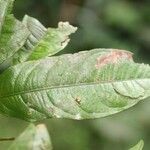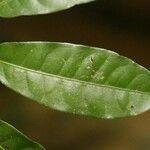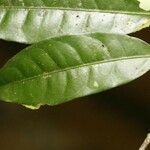Small tree or shrub; branches often scandent, young branches quadrangular. Petiole 3-8 mm long; blades chartaceous, brownish green or glaucescent above when dried, yellowish green below, narrowly elliptic, ovate or oblong, 8-20(-28) x 2.5-7(-9) cm, margins crenulate, apex acuminate or cuspidate, acumen to 2.5 cm long, base obtuse, rounded or acute; primary vein prominent on both surfaces, secondary veins 6-12 per side, widely arcuately ascending, slightly impressed to prominulous above, prominulous below, tertiary veins inconspicuous above, slightly prominulous or indistinct below, often at right angles from the primary vein. Inflorescence thyrsoid, 2-10 cm long with short branches that thicken in the fruiting stage; peduncle ca. 5 mm long; bracts oblong-ovate, acute, 1.5-2 mm; pedicels less than 1 mm long, stout. Flowers to ca. 5 mm diam.; sepals green or yellow to deep-brown, deltoid-ovate to semiorbicular, 0.7-1.3 x 1.2-1.7 mm; petals thin-camose, brownish red or dark yellow with crimson margins or brownish orange, dotted or lineate, elliptic or obovate, 1.5-2.6 x 1.2-2 mm; disk consisting of 3 staminiferous pockets, 0.3-0.4 mm high; filaments 0.4-0.7 mm long, anthers 0.2 x 0.3 mm; ovary 1-1.8 mm diam., ovules 2 per locule, stigmas linear, entire, the tips to 0.5 mm long. Fruit on thickened pedicel, coriaceous, often lenticellate, green, greenish yellow or orange, usually with 3 paler, longitudinal bands, globose, oblong-ellipsoid, or somewhat trigonous (occasionally peanut-shaped), 3.5-5 x 3 cm, with long persistent perianth, pericarp 1-2 mm thick; seeds 3-6, angled, to 1.5 cm long, red or dark brown.
More
Shrub or slender tree up to 12 m. high, the branches often scandent. Leaves with the blade oblong or elliptic-oblong or ovate-oblong, obtuse or subacute at the base, acuminate at the apex, narrowly revolute and subentire or crenate at the margins, 8-20 cm. long and 2.5-8 cm. broad, chartaceous, the costa prominent on both sides. Inflorescences short-pedunculate, thyrsoid, 2-10 cm. long. Flowers congested in ultimate dichotomies or paired at the end of ultimate branchlets, the pedicel stout, very short and usually less than 1 mm. long; sepals broadly deltoid-ovate or semiorbicular, obtuse at the apex, entire or faintly erosulous at the mar-gins, 0.7-1.3 mm. long; petals 5, suberect, oblong or obovate-oblong, rounded at the apex, entire at the margins, 1.5-2.6 mm. long, subcarnose or subcoriaceous, opaque or obscurely lineolate; lips of the disc 0.3-0.4 mm. high; filaments of the stamens ligulate, 0.4-0.7 mm. long, the anthers about 0.2 mm. long and 0.3 mm. broad; ovary 1-1.3 mm. in diam., the ovules 2 per cell and collateral, the stigmas linear and obtuse. Fruits spherical or oblong-ellipsoid, up to 3.5 cm. long and 3 cm. broad, the pericarp 1-2 mm. thick, obscurely rugulose, often lenticellate; seeds few, 4-6, often superposed in pairs, ovate, up to 15 mm. long.
A shrub or small tree. It grows 4-6 m high. It can lean over or be a creeper. The leaves are papery. They are 10-14 cm long. The flowers are in small groups in or near the axils of leaves. The flowers are very small. The fruit are like berries and have a juicy pulp. They are 3 cm long by 2.5 cm wide.




